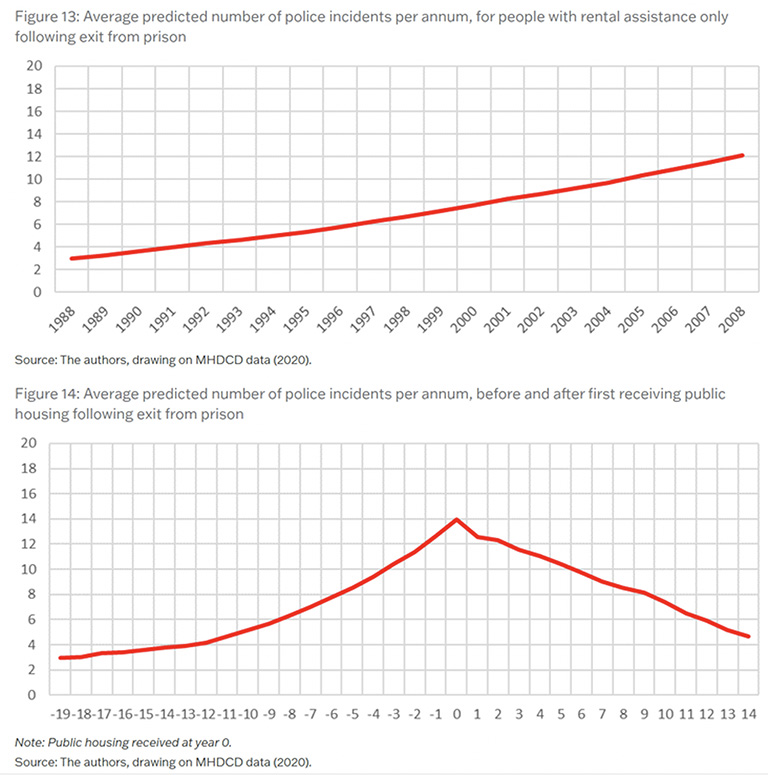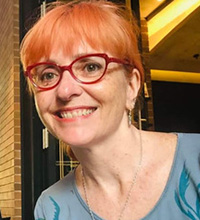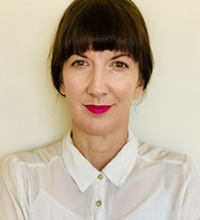Ex-prisoners who get public housing have significantly better criminal justice outcomes than those who receive private rental assistance only.
‘Going home’ is a classic metaphor for exiting prison. But most people exiting prison in Australia either expect to be homeless, or don’t know where they will be staying when released.
Our recent research for AHURI (the Australian Housing and Urban Research Institute) shows post-release housing assistance is a potentially powerful lever in arresting the imprisonment-homelessness cycle.
We found ex-prisoners who get public housing have significantly better criminal justice outcomes than those who receive private rental assistance only. The benefit, in dollar terms, of public housing outweighs the cost.
The imprisonment-homelessness connection
There is strong evidence linking imprisonment and homelessness. Post-release homelessness and unstable housing is a predictor of reincarceration. And prior imprisonment is a known predictor of homelessness. It is a vicious cycle.
People in prison often contend with:
- mental health conditions (40%)
- cognitive disability (33%)
- problematic alcohol or other drug use (up to 66%)
- past homelessness (33%).
People with such complex support needs are often deemed ‘too difficult’ for community-based support services and so end up entangled in the criminal justice system. Also, prisons are themselves places of stress and suffering. So people leaving prison a high-needs group for housing assistance and support.
There are about 43,000 people in prison in Australia. Over the year there will be even more prison releases (because some people exit and enter multiple times).
Ex-prisoners are the fastest growing client group for Australia’s Specialist Homelessness Services. Over the past decade, imprisonment rates in Australia have been rising.
According to the latest published data:
- only 46% of releasees expect to go to their own home (owned or rented) on release
- more expect to be in short-term or emergency accommodation (44%) or sleeping rough (2%), or
- they don’t know where they will stay.
Ex-prisoners are the fastest growing client group for Australia’s Specialist Homelessness Services. Over the past decade, imprisonment rates in Australia have been rising.
Meanwhile, funding for social housing – public housing provided by state governments, and the community housing provided by non-profit community organisations – has been declining in real terms. We must turn both those trends around.
The difference public housing makes
In our research, we investigated the effect of public housing on post-release pathways. We analysed data about a sample of people with complex support needs who had been in prison in New South Wales (NSW).
The de-identified data show peoples’ contacts before and after prison with various NSW government agencies, including criminal justice institutions and DCJ Housing, the state public housing provider.
Police incidents for the public housing group had a rising trend, until they received public housing, after which police incidents went down 8.9% per year.
We compared 623 people who received a public housing tenancy at some point after prison with a similar number of people who were eligible for public housing but received private rental assistance only (such as bond money). On a range of measures, the public housing group had better criminal justice outcomes.
The charts below compare the number of police incidents for each group. The first chart shows recorded police incidents for the private rental assistance group, which gradually rose over the period for which we have data.
The second chart shows police incidents for the public housing group: they also had a rising trend, until they received public housing (year 0 on the x-axis), after which police incidents went down 8.9% per year.

Police incidents, private rental assistance and public housing groups (author provided).
For the housed group:
- court appearances were down 7.6% per year
- proven offences (being found guilty of something at trial) were down 7.6% per year
- time in custody was down 11.2% per year
- time on supervised orders (court orders served in the community, including parole) initially increased, then went down 7.8% per year
- justice costs per person, following an initial decrease of A$4,996, went down a further $2,040 per year per person.
When we put a dollar value on these benefits, providing a public housing tenancy is less costly than paying Rent Assistance in private rental (net benefit $5,000) or assisting through Specialist Homelessness Services (net benefit $35,000).
Unfortunately, public housing is in very short supply. For our public housing group, the average time between release and public housing was five years. Others are never housed.
Post-release pathways are fraught
We interviewed corrections officers, reintegration support workers, housing workers, and people who had been in prison, across three states. They were unanimous: there is a dearth of housing options for people exiting prison.
People want to come back to custody because they’ve then got a roof over their head. They don’t have to worry; they’re getting fed, they can stay warm.”
Tasmanian Corrections Officer
A Tasmanian ex-prisoner, who lived in a roof-top tent on his car on release, said: “You basically get kicked out the door and kicked in the guts and they say, ‘Go do whatever you need to do, see ya’.”
Planning for release is often last-minute. An NSW reintegration support worker told us: “It’s not co-ordinated. We’ll get a prison ringing up on the day of release saying, ‘Can you pick this woman up?’ on the day of release, when they knew it was coming months in advance. There’s no planning.”
A housing worker in Victoria described those next steps as a series of unstable, short-term arrangements, beset by pitfalls: “They could easily be waiting a couple of years, realistically. And for them that’s a long time, and so far off in the distance it’s difficult to conceive of.
“And a long time in which things could go wrong in their lives – to be homeless or back in prison, all sorts of things … What they do in the meantime: they couch surf, stay with family, stay in motels, stay in cars/stolen cars, stay with friends, sleep rough, all those things.”
A Tasmanian corrections officer told us: “People want to come back to custody because they’ve then got a roof over their head. They don’t have to worry; they’re getting fed, they can stay warm.”
It’s not just about housing support
Community sector organisations specialising in supporting people in contact with the criminal justice system, such as the Community Restorative Centre (CRC) in NSW, do extraordinary work providing services and support that aim to break entrenched cycles of disadvantage and imprisonment. However, this sector’s funding has been turbulent, marked by short-term programs.
In another project by some members of this research team, we saw the difference CRC made to 275 of its clients over a number of years. This evaluation found supported clients had 63% fewer custody episodes than a comparison group – a net cost saving to government of $10-16 million.
These support services would be even more effective if clients had more stable housing. As it is, specialist alcohol and other drug case workers are often spending their time dealing with clients’ housing crises.
Secure, affordable public housing is an anchor for people exiting prison as they work to build lives outside of the criminal justice system. It is also a stable base from which to receive and engage with support services. It pays to invest in both.
About the Authors
 Chris Martin is a Senior Research Fellow in the City Futures Research Centre at the University of New South Wales (UNSW). Chris has been involved in housing policy and practice for more than 20 years. His research interests are in rental housing and housing affordability, with special interest in tenancy law; the private rental market and related institutions; social housing; boarding houses, lodging and other forms of marginal rental accommodation; housing and taxation; housing and criminology and criminal justice; and the history of housing policy.
Chris Martin is a Senior Research Fellow in the City Futures Research Centre at the University of New South Wales (UNSW). Chris has been involved in housing policy and practice for more than 20 years. His research interests are in rental housing and housing affordability, with special interest in tenancy law; the private rental market and related institutions; social housing; boarding houses, lodging and other forms of marginal rental accommodation; housing and taxation; housing and criminology and criminal justice; and the history of housing policy.
 Eileen Baldry AO (BA, DipEd, MWP, PhD) is Deputy Vice Chancellor Inclusion and Diversity and Professor of Criminology, UNSW Sydney. She has taught social policy, social development and criminology over the past 30 years. Her research and publications focus on social justice and include mental health and cognitive disability in the criminal justice system; criminalised women and Indigenous Australian women and youth; education, training and employment for prisoners and ex-prisoners; homelessness and transition from prison; Indigenous justice; and community development and social housing.
Eileen Baldry AO (BA, DipEd, MWP, PhD) is Deputy Vice Chancellor Inclusion and Diversity and Professor of Criminology, UNSW Sydney. She has taught social policy, social development and criminology over the past 30 years. Her research and publications focus on social justice and include mental health and cognitive disability in the criminal justice system; criminalised women and Indigenous Australian women and youth; education, training and employment for prisoners and ex-prisoners; homelessness and transition from prison; Indigenous justice; and community development and social housing.
 Research Associate Patrick (Pat) Burton holds an MA in Criminology and Corrections from the University of Tasmania 2013. His late entry into academia followed 27 years in the transport industry, then over 20 years working in the community sector including as a youth worker, agency manager, care worker, correctional officer and agency case worker. Between 2005 and 2008, Pat led the design and delivery of a number of reintegration programs for men exiting prison as a case worker of Bethlehem House Men’s Homeless Shelter in Hobart.
Research Associate Patrick (Pat) Burton holds an MA in Criminology and Corrections from the University of Tasmania 2013. His late entry into academia followed 27 years in the transport industry, then over 20 years working in the community sector including as a youth worker, agency manager, care worker, correctional officer and agency case worker. Between 2005 and 2008, Pat led the design and delivery of a number of reintegration programs for men exiting prison as a case worker of Bethlehem House Men’s Homeless Shelter in Hobart.
 Dr Rebecca Reeve has been a part-time Senior Research Fellow at UNSW since 2015, and the Chief Impact Officer at the Social Outcomes Lab (SOULAB). Her research focuses on vulnerable Australian populations. At UNSW, Rebecca’s primary role is with Yuwaya Ngarra-li – a partnership between the Dharriwaa Elders Group and UNSW to improve the wellbeing, social, built and physical environment and life pathways of Aboriginal people in Walgett. She also works with the City Futures Research Centre at UNSW, investigating the impact and cost effectiveness of housing assistance for ex-prisoners.
Dr Rebecca Reeve has been a part-time Senior Research Fellow at UNSW since 2015, and the Chief Impact Officer at the Social Outcomes Lab (SOULAB). Her research focuses on vulnerable Australian populations. At UNSW, Rebecca’s primary role is with Yuwaya Ngarra-li – a partnership between the Dharriwaa Elders Group and UNSW to improve the wellbeing, social, built and physical environment and life pathways of Aboriginal people in Walgett. She also works with the City Futures Research Centre at UNSW, investigating the impact and cost effectiveness of housing assistance for ex-prisoners.
 Rob White is Professor of Criminology at the University of Tasmania. He has written extensively in the areas of criminology, youth studies and public policy, with a special interest in environmental harm and eco-justice, youth gangs and violence, and innovative justice versus punitive measures.
Rob White is Professor of Criminology at the University of Tasmania. He has written extensively in the areas of criminology, youth studies and public policy, with a special interest in environmental harm and eco-justice, youth gangs and violence, and innovative justice versus punitive measures.
 Associate Professor Ruth McCausland is UNSW Director of Yuwaya Ngarra-li, a community-led partnership with the Dharriwaa Elders Group in Walgett that grew from research collaboration on the incarceration of Aboriginal people with mental and cognitive disability. Ruth has worked over the past 25 years in the fields of criminology, evaluation, human rights and community development. Her research focuses on systemic and community-led responses to criminalisation and incarceration.
Associate Professor Ruth McCausland is UNSW Director of Yuwaya Ngarra-li, a community-led partnership with the Dharriwaa Elders Group in Walgett that grew from research collaboration on the incarceration of Aboriginal people with mental and cognitive disability. Ruth has worked over the past 25 years in the fields of criminology, evaluation, human rights and community development. Her research focuses on systemic and community-led responses to criminalisation and incarceration.
 Professor Stuart Thomas specialises in mental health epidemiology, and is based at RMIT University. His background is in psychology and law; he completed his PhD in Health Services Research specialising in Forensic Mental Health at the Institute of Psychiatry, King’s College London. Stuart’s research interests span police contact with vulnerable and otherwise marginalised populations, mental health stigma, missing persons, police decision-making, police use of force and outcome measurement.
Professor Stuart Thomas specialises in mental health epidemiology, and is based at RMIT University. His background is in psychology and law; he completed his PhD in Health Services Research specialising in Forensic Mental Health at the Institute of Psychiatry, King’s College London. Stuart’s research interests span police contact with vulnerable and otherwise marginalised populations, mental health stigma, missing persons, police decision-making, police use of force and outcome measurement.
This article first appeared on The Conversation, and is republished here under a Creative Commons Licence; you can read the original here.
Picture © Kodda / Shutterstock


